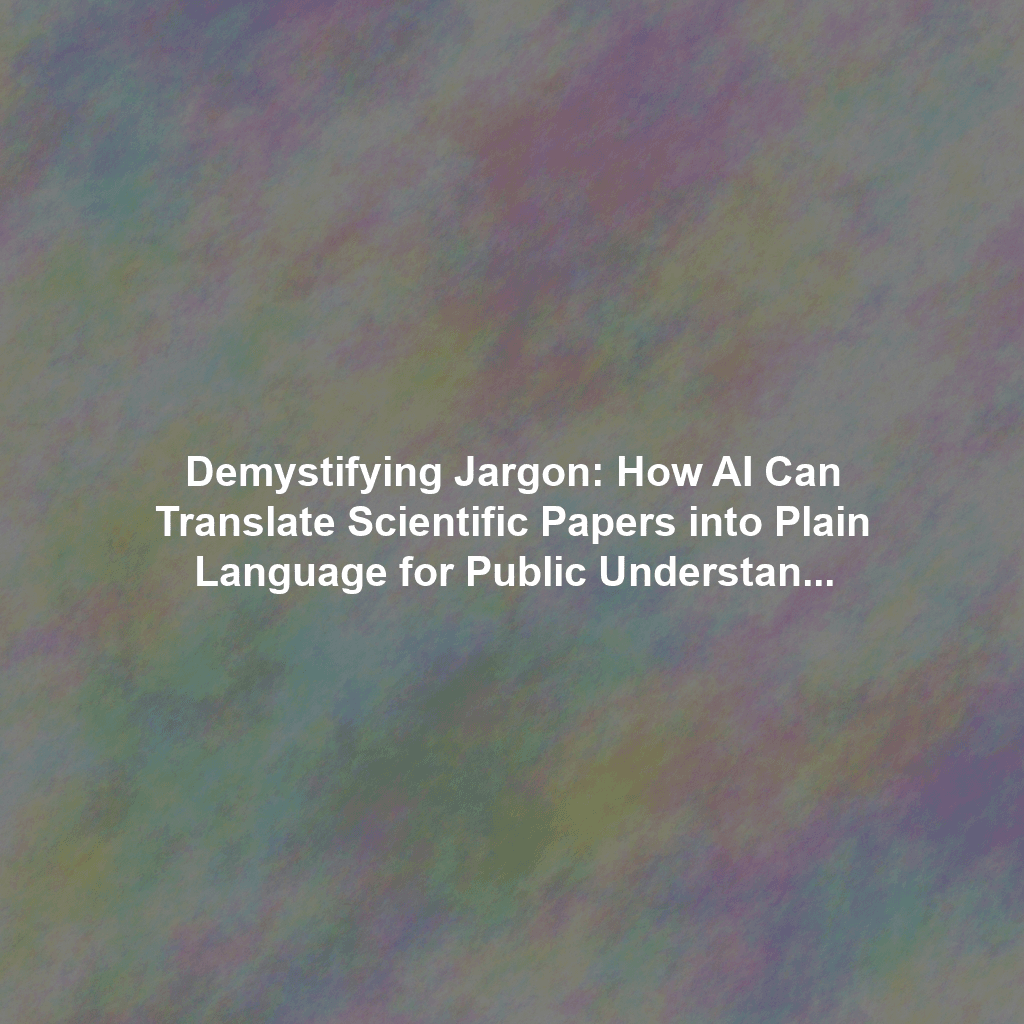Scientific research is the bedrock of progress, driving innovation and shaping our understanding of the world. However, the language used in scientific papers often acts as a barrier, preventing crucial findings from reaching the broader public. This is where Artificial Intelligence (AI) offers a promising solution: the ability to translate complex scientific terminology and concepts into plain language, making research accessible to a wider audience. But can AI-generated content truly bridge this gap effectively, and what are the potential challenges?
The Promise of AI in Simplifying Science
The sheer volume of scientific literature published each year is staggering. Scientists themselves struggle to keep up with research outside their specific niche. For the average person, navigating the jargon-laden world of scientific papers is virtually impossible. AI can analyze complex text, identify key concepts, and rephrase them in a more understandable way. This has the potential to democratize knowledge, empowering individuals to make informed decisions based on scientific evidence.
How AI Tools Work: A Simplified Explanation
AI-powered tools for scientific communication often rely on a combination of Natural Language Processing (NLP) techniques. These include:
- Text summarization: Condensing lengthy papers into concise summaries that capture the main points.
- Jargon identification and substitution: Identifying technical terms and replacing them with simpler, more common words or providing clear definitions.
- Concept extraction: Identifying the key ideas and relationships within the text, allowing for a more logical and intuitive explanation.
- Sentence simplification: Restructuring complex sentences into shorter, easier-to-understand sentences.
Examples of AI Applications in Scientific Communication
Several platforms and tools are already leveraging AI to translate scientific information for public consumption:
- Research Summary Generators: Tools that automatically create summaries of research papers, highlighting key findings and methodologies in accessible language.
- AI-Powered Glossary Builders: These tools create glossaries of technical terms used in specific fields, allowing readers to quickly look up unfamiliar words.
- Platforms for Public Engagement: Some platforms use AI to match scientific experts with members of the public who have questions about specific research topics.
- AI-Driven Content Creation for Science Blogs and Websites: Using AI to generate initial drafts of articles explaining scientific concepts for a broader audience. These drafts can then be reviewed and refined by human editors.
For example, an AI tool might take a sentence like “The expression of microRNA-21 was significantly upregulated in hepatocellular carcinoma tissues, suggesting a potential role in tumorigenesis” and translate it to “The amount of a tiny molecule called microRNA-21 was found to be higher in liver cancer tissues. This suggests it might play a role in the development of the cancer.“
Impact on Public Comprehension and Engagement
The potential impact of AI-powered scientific communication is significant. By making research more accessible, it can:
- Increase public understanding of science: Empowering individuals to make informed decisions about their health, the environment, and other important issues.
- Improve science literacy: Fostering a greater appreciation for the scientific process and its importance in society.
- Promote public engagement with science: Encouraging more people to participate in scientific discussions and contribute to scientific advancements.
- Facilitate faster dissemination of knowledge: Allowing research findings to reach a wider audience more quickly, accelerating innovation and discovery.
Potential Pitfalls and How to Avoid Them
Oversimplification and Loss of Nuance
One major concern is oversimplification, which can lead to inaccuracies or a misunderstanding of the research findings. Complex scientific concepts often require careful explanation and nuance, which can be lost when AI attempts to condense them into simpler terms. To mitigate this:
- Human Oversight: Always have a human expert review and edit AI-generated content to ensure accuracy and completeness.
- Context is King: Provide sufficient context when explaining complex concepts, avoiding overly simplistic analogies or metaphors.
- Transparency: Clearly indicate when AI has been used to generate content, and highlight any potential limitations.
Bias and Misrepresentation
AI models are trained on data, and if that data is biased, the AI will perpetuate those biases. This can lead to misrepresentation of research findings or the promotion of certain viewpoints over others. To address this:
- Diverse Datasets: Use diverse and representative datasets to train AI models, minimizing the risk of bias.
- Bias Detection Tools: Employ tools to detect and mitigate bias in AI-generated content.
- Critical Evaluation: Encourage critical evaluation of AI-generated content, reminding readers to consider the source and potential biases.
Maintaining Accuracy and Trust
Maintaining accuracy is paramount. Misinformation in science can have serious consequences, particularly in areas like healthcare. To ensure accuracy:
- Fact-Checking: Implement rigorous fact-checking processes to verify the information presented in AI-generated content.
- Expert Review: Involve subject matter experts in the review process to identify and correct any errors.
- Citations and Sources: Clearly cite the original research papers and other sources used to generate the content.
The Future of AI in Scientific Communication
As AI technology continues to evolve, its role in scientific communication will only grow. We can expect to see more sophisticated AI tools that can not only translate complex language but also tailor explanations to different audiences, personalize learning experiences, and even generate interactive simulations to help people understand scientific concepts more intuitively. The key is to use these tools responsibly, with a focus on accuracy, clarity, and ethical considerations. By embracing AI thoughtfully, we can unlock the vast potential of scientific research and make it accessible to everyone.
Conclusion
AI offers a powerful solution for breaking down the language barriers that prevent the public from engaging with scientific research. By translating complex jargon into plain language, AI can empower individuals to make informed decisions and participate in scientific discussions. However, it’s crucial to be aware of the potential pitfalls of oversimplification, bias, and inaccuracy. By implementing appropriate safeguards and prioritizing human oversight, we can harness the power of AI to democratize scientific knowledge and foster a more informed and engaged public.
 Skip to content
Skip to content

